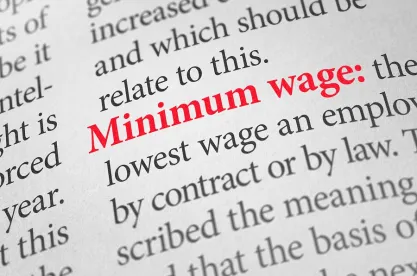There has been significant coverage of recent amendments to the Illinois Minimum Wage Law (IMWL), which increased the minimum wage by $1 per hour effective January 1 of each year until it reaches $15 per hour on January 1, 2025.
But what has been far less publicized is that the amendments also include steep increases in damages that can be recovered for violations. Since the law not only covers required minimum wage but also overtime pay for hours worked over 40 in a workweek, these considerable increases in penalties can result in significant liability, particularly in the typical case involving overtime pay. Also, since most wage hour cases are brought as class actions on behalf of large groups of employees, the potential exposure can be staggering.
Before the amendments were enacted, an employee claiming underpayment of minimum wage or overtime pay was entitled to the amount of any underpayment plus damages of 2 percent of the underpayment for each month that the pay was incorrect. Under the amended IMWL, a prevailing employee is now entitled to 5 percent of the underpayment for each month that the pay was incorrect plus three times the amount of the underpayment.
To illustrate the impact of these increases, take an employee who claims he is owed $600 for overtime work he did in one month three years ago. (Three years is the statute of limitations for claims under IMWL). Under the previous version of the law, if the employee prevailed, he would be entitled to $1,032 ($600 plus damages of $432 [$600 x 2 percent x 36 months]). Under the new version of the law, however, on that same $600 underpayment the employee would receive $2,880 ($1,800 [3 x $600] plus additional damages of $1,080 [$600 x 5 percent x 36 months]). In all, the employee would be entitled to almost five times the underpayment.
Because in this example there is just one employee and all he is claiming is underpayment of overtime for one month, this might not sound that extreme. But now change the scenario to a more common one. Let's say the employee claims he is owed the overtime pay because he is a salaried employee who was misclassified as exempt from overtime pay. And let's say he is claiming that because of that alleged misclassification, he was underpaid $600 in overtime pay every month for the past three years and that he continues to be misclassified and underpaid. And let's further say he claims there are 40 other salaried employees who were similarly misclassified, so he is bringing a lawsuit on behalf of himself and them as their class representative. If we just counted underpayments, the claims could potentially amount to a high six-figure number. But add in the penalties of 5 percent of the underpayment for each month that the pay was incorrect, plus triple the amount of the underpayments, and the exposure now is a significant multiple of that amount – at least several million dollars. And this is before adding in attorneys' fees.
The concern is heightened when it is considered that many types of overtime claims involve technical issues that even careful and well-meaning employers can easily get trapped in. For example, some overtime cases involve time not counted in clocking in or clocking out, such as when donning and doffing clothing or safety gear. Even if it is only 10 minutes a day that is disputed, the exposure can potentially be massive if it involves a large work force.
Minimizing Risk of Wage and Hour Lawsuits
Exposure to wage and hour lawsuits has always been a considerable risk. But now with the significant penalties piled on top of backpay liability, such cases now can be ruinous for Illinois employers.
There are steps that an employer can take to mitigate against such a consequence. One is to conduct periodic self-audits of wage and hour practices to ensure that payroll and timekeeping practices comply with Illinois and federal wage and hour laws. Employers can also purchase an Employment Practices Liability Insurance policy that will provide coverage for such claims. Unfortunately, while such coverage might provide for cost of defense (up to a limit), it seldom covers liability.
Perhaps the best approach is to adopt a dispute resolution policy that provides for binding private arbitration of wage and hour disputes (and perhaps other types of claims relating to employment) with class action waivers to minimize the risk of class action claims. The U.S. Supreme Court has held that such agreements are enforceable. In this way, while an employer might still be liable to individual employees for wage and hour violations, including the drastic penalties described above, it might be able to avoid class action suits in which the penalty amounts can skyrocket.




 />i
/>i
